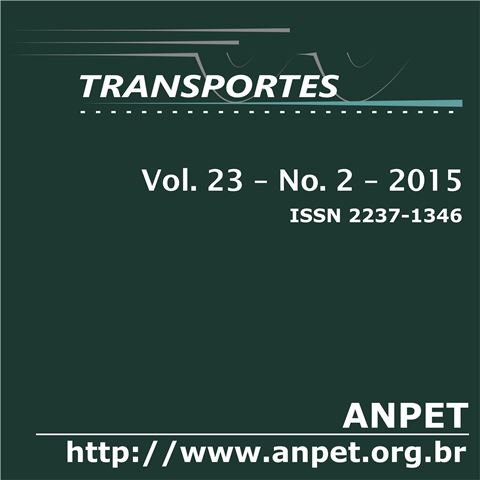.
DOI:
https://doi.org/10.14295/transportes.v23i2.882Keywords:
Traffic accidents in cities, urban structure, Bayesian models.Abstract
In recent years, the explanation of traffic accidents tended to focus on the urban spatial structure. It is considered that certain features of the environment (e.g. land use, road system, economic activities, population and intensity of vehicular flows) are indirect factors that favor the occurrence of collision traffic accidents in urban areas. The central part of the in-trametropolitan zone of Toluca in Mexico) records elevated rates of traffic accidents. This research aims to identify the physical elements of the urban structure, which affects most of the risks about traffic accidents, in the study area, at AGEB level (which stands for the Basic Geo-statistical Area). Three Bayesian models are being used in order to achieve the research objective: Bivariant Poisson-Gamma, Multivariate and Negative Binomial probabilistic. The results indicate that vehicular flows and employment density are the most related variables linked to the risk of collision traffic accidents, in the study area.Downloads
References
Aguero-Valverde, J. & P. P. Jovanis, (2006) Spatial analysis of fatal and injury crashes in Pennsylvania. Journal of Accident Analysis and Prevention, v.38, p.618–625: DOI:10.1016/j.aap.2005.12.006
Alcántara, V. E., (2010) “Análisis de movilidad urbana. Espacio, medio ambiente y equidad”. Ed. CAF. Bogotá, Colombia. p. 204.
Boher, J. H. I. (2006). Pacto por la Movilidad. La seguridad vial en Barcelona, España. Ayuntamiento de Barcelona. p. 48. w110.bcn.cat/fitxers/mobilitat/pacte/pacte8e.380.pdf.
Campero, A. C., (2011). Pronóstico de accidentes viales en intersecciones de la ciudad de Toluca utilizando enfoque Bayesiano. (Tesis inédita de maestría). Universidad Autónoma del Estado de México, México.
Campos, A. J., (2009). La Geografía de la marginación: enfoque conceptual y metodológico alternativo para el caso de México. (Tesis inédita de doctorado). Universidad Nacional Autónoma de México, México.
Consejo Nacional de Población CONAPO, (2005). Indice de marginación a nivel localidad (Anexo C Metodología de estimación del índice de marginación). SEGOB. D.F., México. www.conapo.gob.mx/es/CONAPO/Indice_de_marginacion_a_nivel_localidad_2005.
Clarke, D., P. Ward, C. Bartle, W. Truman, (2006), Young driver accidents in UK: the influence of age, experience, and time of day. Journal of Accident Analysis and Prevention, v.38 p. 871-878. DOI:10.1016/j.aap.2006.02.013
Clifton, K., J. Carolina, V. Burnier, & A. Gulsah, (2009). Severity of injury resulting from pedestrian–vehicle crashes: What can we learn from examining the built environment. Journal Transportation Research Part D, v.14, p. 425–436. DOI:10.1016/j.trd.2009.01.001
Chueca, G. F., (1997). Breve historia del urbanismo. España: Editorial Alianza.
Christie, N. (2000). The high risk child pedestrian: socio-economic and environmental factors in their accidents. PR 117. Journal TRL. p. 33.
De Mattos, (2002). Transformación de las ciudades latinoamericanas: ¿Impactos de la globalización? EURE, v.28 p. 5-10.
European Road Safety Observatory (2006). Novice Drivers. retrieved april 10, 2007 from www.erso.eu.
Field A., (2005). Discovering statistics using SPSS. Londres, UK: Sage.
Fuentes, F. C. M. & H. V. Hernández (2009). La estructura espacial urbana y la incidencia de accidentes de tránsito en Tijuana, Baja California (2003-2004). Redalyc Frontera Norte 2009, v. 21 p.109-138: Disponible en: www.redalyc.uaemex.mx/src/inicio/ArtPdfRed.jsp?iCve=13612040005.
Garrocho, C. & J. A.Campos, (2005). La población adulta mayor en el área metropolitana de Toluca, 1990-2000. Papeles de Población, Año 11, v. 45, p. 71-106: Disponible en: www.redalyc.uaemex.mx/pdf/112/11204505.pdf.
Garrocho, C. & Z. Flores, (2009). Delimitación del centro tradicional de comercio y servicios del Área Metropolitana de Toluca. Papeles de Población, v.15, p.233-274.
Garrocho, R. C., (2013). “Dinámica de las ciudades de México en el siglo XXI. Cinco vectores clave para el desarrollo sostenible”. México, ONU: Fondo de Población (UNFPA)-Conapo-El Colegio Mexiquense, México.
Garza, N., (2009). Dilema económico-ambiental del urbanismo en ciudades latinoamericanas. Investigación y Desarrollo, v. 17, p. 288-327. Universidad del Norte Barranquilla, Colombia. Disponible en: www.redalyc.org/pdf/268/26816278004.pdf.
Graham, D., S. Glaister, & R. Anderson, (2005). The effects of area deprivation on the incidence of child and adult pedestrian casualties in England. Journal of Accident Analysis and Prevention v.37, p.125–135. DOI: 10.1016/j.aap.2004.07.002
Graizbord, B., (2008). “Geografia del Transporte en el Area Metropolitana de la Ciudad de Mexico”. Cedua, El Colegio de México. D.F., México. p. 386.
Gregory, P. C., (2005). “Bayesian logical data analysis for the phisycal sciences. A comparative approach with mathemática support”. Cambrige University Press. New York, United States. p. 468. www.cambridg e.org /9780521841504
Hadayeghi, A., A.S. Shalaby, & B.N. Persaud. (2003). Mac-rolevel accident prediction models for evaluating safety of urban transportation systems. Journal of Safety and Human perfor-mance, v.1840 p.87-95: http://trb.metapress.com/con-tent/av604731263mn076/.
Instituto Nacional de Estadistica y Geografía, INEGI, (2009). Directorio Estadístico Nacional de Unidades Económicas. México. http://www3.inegi.org.mx/sistemas/mapa/denue/default.aspx.
Instituto Nacional de Estadistica y Geografía, INEGI, (2005). Censos y Conteos de población y vivienda. Conteos de Población y Vivienda 2005. México. www.inegi.org.mx/est/contenidos/pro-yectos/ccpv/cpv2005/.
Jones, A. P., R. Haynes, V. Kennedy, I. M. Harvey, T. Jewell, & D. Lea, (2008). Geographical variations in mortality and morbid-ity from road traffic accidents in England and Wales. Journal of Health & place, v.14, p. 519-535. DOI:10.1016/j.health place.2007.10.001.
Kim, K., I.M. Brunner & E.Y. Yamashita, (2006). The influence of land use, population, employment and economic activity on Accidents. Journal of Safety and Human performance, v.1953, p. 56–64, TRB, National Research Council, Washington DC: Dis-ponible en: www.trb.metapress.com/content/y188nx845j77566v/.
Lord, D., S. M. Washington, & J. N. Ivan, (2005). Poisson-gamma and zero inflacted regression models of motor vehicle crashes: balancing statistical fit and theory. Journal of the trans-portation research board. v.37, p. 35-46.
Miaou, S. & D. Lord, (2003). Modeling traffic crash-flow rela-tionship for intersections. Dispersion parameter, functional form, and Bayes versus empirical Bayes methods. Journal of Transpor-tation Research Record v. 1840, p. 31-41. DOI:10.3141/1840-04
Miaou, S. & J. Jin (2005). Bayessian ranking of sites for engi-neering safety improvements: Decision parameter, treatability concept, statistical criterion, and spatial dependence. Journal of Accident Analysis and Prevention. v. 37, p. 699-720. DOI:10.1016/j.aap.2005.03.012
Miranda, M. L. F., L. Fu, F. F. Saccomanno, & A. Labbe, (2005). Alternative risk models for ranking locations for safety improve-ment. Journal of the Transportation Research Board No. 1908, Transportation Research Board of the National Academies, Washington, D.C., p. 1-8. DOI: 10.3141/1908-01
Negrete, P. M., (2002). Las metrópolis latinoamericanas en la red mundial de ciudades: ¿megaciudades o ciudades globales? Edita Instituto Juan de Herrera 4. 28040 MADRID. ESPAÑA. p. 10. http://habitat.aq.upm.es/boletin/n22/ampez.html.
Noland, B. R. & M. A. Quddus, (2003). A spatially disaggregate analysis of road casualties in England. Journal of Accident Anal-ysis and Prevention. v. 36 p. 973–984. DOI: 10.1016/j.aap.2003.11.001.
Peden, M., R. Scurfield., D. Sleet, Mohan, D., A. Adnan, Hyder, E. Jarawan & C. Mathers, (2004). World report on road traffic injury prevention. Geneva: World Health organization.
Pulugurtha, S. S., V. R. Duddu, & Y. Kotagiri, (2012). Traffic analysis zone level crash estimation models based on land use characteristics. Journal of Accident Analysis and Prevention. v. 50 p. 678-687 DOI: 10.1016/j.aap.2012.06.016.
Quddus, M. A., (2008). Modelling area-wide count outcomes with spatial correlation and heterogeneity: An analysis of London crash data. Journal of Accident Analysis and Prevention. v. 40 p. 1486–1497. DOI:10.1016/j.aap.2008.03.009
Rodríguez F. G. (2012). Sistema de consulta Geoelectoral para el Estado de México. Periodo 1990-2009. (Tesis inédita de maes-tría), Universidad Autónoma del Estado de México, México.
Siddiqui, Ch., M. Abdel-Aty, K. Choi, (2012). Macroscopic spa-tial analysis of pedestrian and bicycle crashes. Journal of Acci-dent Analysis and Prevention. v. 45, p. 382-391. DOI:10.1016/j.aap.2011.08.003
Spiegelhalter D., A. Thomas, Best Nicky & D. Lunn. (2003). “Manual. WinBUGS User Manual. Versión 1.4”. MRC Biostatis-tics Unit, Intitute of Public Health, Robinson Way, Cambridge CB2 2SR, UK. Departament of Epydemiology & Public Health, Imperial College School of Medicine, Norfolk Place, London W2 1PG, UK.
Downloads
Published
How to Cite
Issue
Section
License
Authors who submit papers for publication by TRANSPORTES agree to the following terms:
- The authors retain the copyright and grant Transportes the right of first publication of the manuscript, without any financial charge, and waive any other remuneration for its publication by ANPET.
- Upon publication by Transportes, the manuscript is automatically licensed under the Creative Commons License CC BY 4.0 license. This license permits the work to be shared with proper attribution to the authors and its original publication in this journal, and to be adapted for non-commercial purposes, provided appropriate credit is given and any derivative works are distributed under the same terms.
- Authors are authorized to enter into additional separate contracts for the non-exclusive distribution of the version of the manuscript published in this journal (e.g., publishing in an institutional repository or as a book chapter), with recognition of the initial publication in this journal, provided that such a contract does not imply an endorsement of the content of the manuscript or the new medium by ANPET.
- Authors are permitted and encouraged to publish and distribute their work online (e.g., in institutional repositories or on their personal websites) after the editorial process is complete. As Transportes provides open access to all published issues, authors are encouraged to use links to the DOI of their article in these cases.
- Authors guarantee that they have obtained the necessary authorization from their employers for the transfer of rights under this agreement, if these employers hold any copyright over the manuscript. Additionally, authors assume all responsibility for any copyright infringements by these employers, releasing ANPET and Transportes from any responsibility in this regard.
- Authors assume full responsibility for the content of the manuscript, including the necessary and appropriate authorizations for the disclosure of collected data and obtained results, releasing ANPET and Transportes from any responsibility in this regard.









